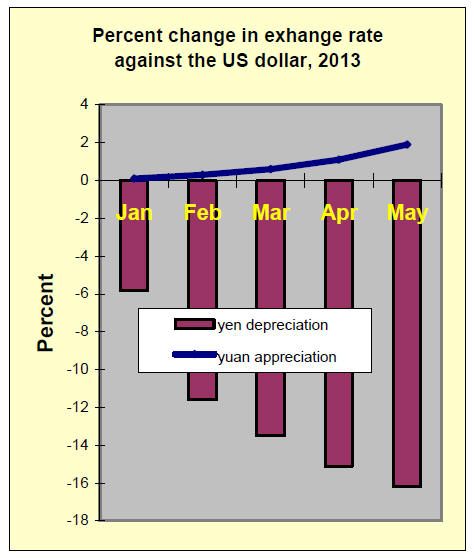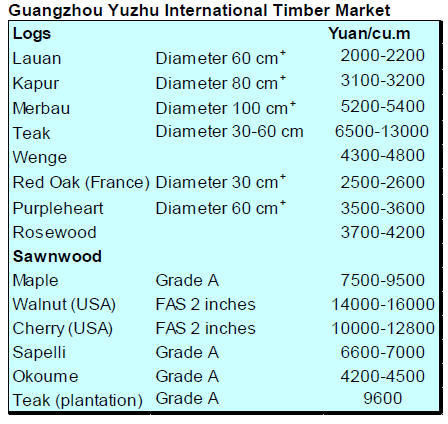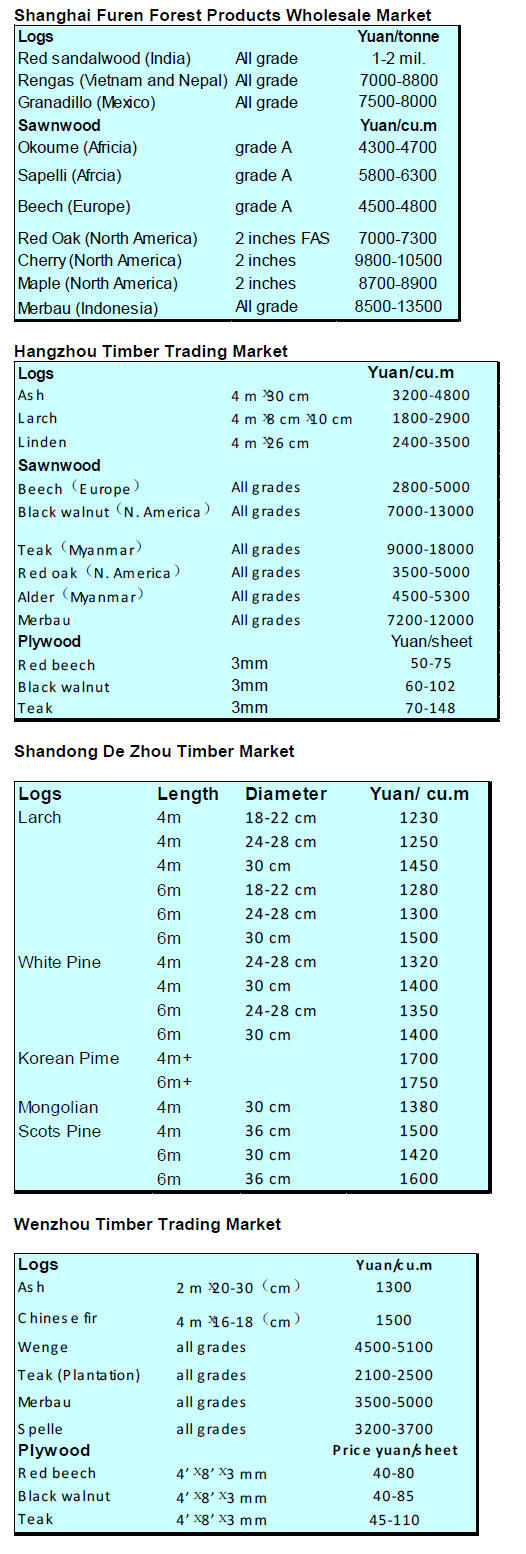US Dollar Exchange Rates of 26th May 2013
China Yuan 6.1314
Report from China
Currency volatility - Chinese exporters focus
on short-term business
The depreciation in the yen has greatly affected China's exports to
Japan. By mid May the accumulated appreciation of the yuan against the
dollar was around 2% but the yuan had strengthened by more than 5%
against the yen.
The strong yuan appreciation has hit Chinese exporter¡¯s profit margins
hard and this extra burden comes on top of the rising costs of raw
materials and labour.
The continued appreciation of the yuan is seriously affecting Chinese
exporters and causing them to focus on short-term business arrangements
instead of longer-term business developments. The challenges in the
export market from very volatile exchange rates are now a threat to the
survival of many small and medium sized businesses according to the
Ministry of Commerce.
A survey of Chinese exporters conducted by the Ministry of Commerce
indicated that more than three quarters of those surveyed experienced
significant declines in profits during the first four months of the
year.
See: http://english.mofcom.gov.cn/article/newsreleases

Increased April domestic sales boost profits
The profits of large Chinese industrial companies improved in April due
mainly to increased sales and this is in sharp contrast to the reported
decline in the manufacturing index that appeared to signal a slowing of
the economy.
The National Bureau of Statistics, in a recent press release, said
company profits in the first four months of the year increased 11
percent. Analysts commented that improved profit levels could stimulate
industrial expansion and that this would help sustain growth in the
economy.
In related news the government has made it clear that the industrial
sector should not sacrifice the environment to ensure short-term growth.
Output Value of China¡¯s Forestry Industry in 2012
According to the State Forestry Administration Annual Forestry
Statistical Yearbook for 2012, the total output value of China¡¯s
forestry industry was RMB3.95 trillion in 2012 (calculated at present
price).
This represents an increase of 29% compared to levels in 2011. The
growth rate in output from China¡¯s forest industry has averaged 23%
since 2001.
The output value from the primary sector was RMB1.37 trillion,
accounting for 35% of the total, up by 24% year on year.
The output value of the secondary processing sector was RMB2.09
trillion, some 53% of total output and up by 25% on 2011 levels. Output
from the tertiary sector was RMB0.48 trillion, accounting for 12% of the
total up by 68% compared with output in 2011.
In recent years, the structure of the three main timber sectors has
changed and at present the proportion of the three main industrial
sectors, primary, secondary and tertiary is 35¡Ã53¡Ã12, this marks a
significant change from the situation at the end of 2005 (the 10th Five
Year Plan) when the distribution was 52¡Ã41¡Ã7. The proportion of
secondary and tertiary industries has steadily increased.
Within the primary sector the output value of economic forest products
such as dry and fresh fruit, tea, herbal medicine and food items was
RMB775 billion or 56% of the total in the primary sector making it the
largest segment.
Amongst the secondary sector outputs the value of timber and bamboo
processing and output from manufacturing including sawnwood and
wood-based panel was RMB823 billion, which at 39% of the total output
from the secondary sector was the largest proportion.
Also, within the secondary sector, the output value of wood and bamboo
pulp paper making was RMB475 billion and the output value of wooden and
bamboo furniture manufacturing industry was RMB279 billion.
In the tertiary industry, the output value of forestry tourism and
leisure services industry was RMB352 billion (73%of the total).
The expansion of new industries in the sector has been rapid with forest
tourism and leisure services industry growing by 89%, output of the oil
tea industry growing by 58% and wild animal breeding expanding by 39%.
Output of logs and sawnwood
In 2012, the total output of roundwood was 81.74 million cubic metres,
being basically the same as in 2011. Industrial log output from national
forest was 74.94 million cubic metres. Fuel wood production in 2012 was
6.80 million cubic metres.
The main log producing areas in 2012 were Guangxi Zhuang Autonomous
Region, Guangdong, Fujian, Shandong, Yunnan, Anhui and Hunan provinces.
The output of sawnwood in 2012 was 55.68 million cubic metres, up by 25%
over that in 2011 while the output of woodchips was 29.07 million cubic
metres, up 30%year on year.
Output of woodbased panel
In 2012, furniture industries, the construction sector and the builders
wood work sector were affected by the forced slowdown of the domestic
real estate industry and by weaker export demand.
As a result of these two factors production of woodbased panels slowed
in 2012. Total output of woodbased panels was 223.36 million cubic
metres, up by 7% in comparison with that of 2011.
The output of plywood in 2012 was 109.81 million cubic metres, (plus 11%
year on year) and accounted for 49% of the total output of woodbased
panels. The output of fibreboard was 58 million cubic metres (of which
50 mil. was MDF), up by 4% on 2011 and accounted for 26% of the total.
Particleboard production was 23.50 million cubic metres, down 8% on 2011
levels. Output of other wood based panels was 32.50 million cubic metres
up by 9% year on year.
Blockboard made up 58% of other woodbased panel output. Other outputs
included veneer, 34.92 million cubic metres and decorative boards 192
million square metres.
At the provincial level, the output of wood-based panel exceed 10
million cubic metres in Shandong, Jiangsu, Guangxi, Henan, Anhui and
Hebei provinces and autonomous regions.
The total output of wood based panels in these six provinces was 163.93
million cubic metres, making up 73% of China¡¯s total output of wood
based panels.
Output of wooden and bamboo flooring
The output of wood and bamboo flooring in 2012 was 604 million square
metres, down by 4% on 2011 and the first drop in many years.
Of the total, the output of wooden flooring was 125 million square
metres, (21% of the total); the output of composite wood flooring was
371 million square metres, (61% of the total); the output of other
wooden flooring and bamboo flooring was 59 million square metres and 49
million square metres respectively.
The largest wood and bamboo flooring producers are Jiangsu and Zhejiang
provinces whose outputs were 144 million square metres and 119 million
square metres respectively.
The national output of rosin products was 1.41 million tonnes in 2012
about the same as in 2011; turpentine output was 187,400 tonnes, up 3%
compared to 2011 while camphor output was 11,400 tonnes.
In 2012, the output of bamboo poles was 1.644 billion pieces an increase
of 7% from levels in 2011. Of the total, the output of Moso bamboo (a
temperate species of giant timber bamboo native to China) was 1.115
billion pieces. The output value of the bamboo industry as a whole
reached RMB122.4 billion in 2012.
Domestic prices of forest products
The average price of logs in 2012 was 757 Yuan/cubic metre, the same
level as in 2011 and the average price for bamboo was 8 Yuan/piece, a
slight increase on 2011.
The average price of sawnwood was 1213 Yuan/ cubic metre, (plus 6% year
on year) and the average price for wood chips was 716 Yuan/cubic metre,
down 17% on 2011 prices.
The average price for wooden flooring was 158 Yuan/square metre, up by
20% in comparison with 2011 and the average price for plywood was 1868
Yuan/cubic metre, down by 9% on 2011.
The average price for MDF was 1505 Yuan/cubic metre, a drop of 11% year
on year but the average price for particleboard was 1103 Yuan/cubic
metre, up by 3% on 2011.
China¡¯s Foreign trade in Forest Products
Because of the sharp drop in demand in the EU, US and Japanese markets
China¡¯s traditional wood product exports such as wood furniture, plywood
and paper fell dramatically in 2012.
The volume of China¡¯s softwood imports also fell sharply in 2012.
While demand weakened in traditional markets demand in emerging markets
steadily increased in 2012 and imports by these markets and increased
imports by the US on the back of improving economic conditions softened
to downward trends in international trade.
A summary analysis from the statistic data of China Customs indicates
that the total import and export value of China¡¯s forest products in
2012 was US$118.83 billion, down just 1% year on year.
Of the total trade exports wereUS$57.57 billion, (plus 5.0% year on
year) while imports were US$61.26 billion a drop of 6% from 2011 levels.
Import of main wood products
In 2012, the volume of log imports was 37.89 million cubic metres valued
at US$7.25 billion, a decline of 10% in volume and 12% in value from
2011. The volume of sawnwood imports in 2012 was 20.67 million cubic
metres worth US$5.52 billion, down 4% in volume and 3.5% in value
compared with levels in 2011.
The volume of paper and paper board imports were 3.254 million tonnes
(down 6% year on year) valued at US$4.6 billion (down 9% year on year).
The volume of paper pulp imports was 16.46 million tons valued at
US$11.04 billion, reflecting a 14% decline in volume and 7% decline in
value compared to 2011.
Imports of wooden furniture amounted to 6.368 million pieces valued at
US$600 million in 2012 up by 15% in terms of number of pieces and up 9%
in value compared to 2011.
Export of main forest product
2012 exports of wooden furniture amounted to 290 million pieces (down
almost 1% year on year) valued at US$18.33 billion (up by 7% year on
year).
China¡¯s exports of paper and paper board totaled 6.065 million tonnes
(plus 1%) valued at US$10.98 billion (plus 6%).
The volume of plywood exports was 10.03 million cubic metres valued at
US$4.8 billion, increasing by 5% and 10% respectively on 2011 figures.


|